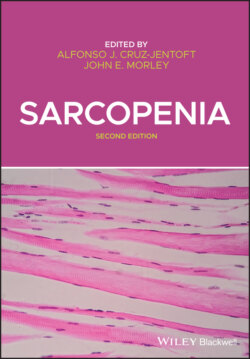Читать книгу Sarcopenia - Группа авторов - Страница 4
List of Illustrations
Оглавление1 Chapter 2Figure 2.1 Differences in fat‐free mass and lean mass using different body c...Figure 2.2 Differences in muscle cross‐sectional area and lean mass using di...Figure 2.3 Annual decline (%) in skeletal muscle mass in older men and women...
2 Chapter 3Figure 3.1 Phosphocreatine (PCr) shuttle: the ATP generated by the complex V...Figure 3.2 Hypothesized mechanisms leading to mitochondrial dysfunction, dec...
3 Chapter 4Figure 4.1 Motor unit remodeling and the denervation–reinnervation phenomeno...
4 Chapter 5Figure 5.1 Regulation of muscle protein mass.Figure 5.2 Activation of insulin signaling pathway by amino acids.
5 Chapter 8Figure 8.1 Lifecourse normative data for grip strength from 12 British studi...Figure 8.2 Relationship between grip strength and diabetic status in older m...Figure 8.3 Association of grip strength with admission outcomes per standard...Figure 8.4 Grip strength mean values from included samples, by region [33]....Figure 8.5 Forest plot of studies assessing the association between birth we...
6 Chapter 9Figure 9.1 Pathogenesis of acute sarcopenia following surgical interventions...
7 Chapter 10Figure 10.1 Modal pathway to adverse outcomes in older persons.Figure 10.2 Clinical frailty scale.
8 Chapter 11Figure 11.1 Muscle and bone cross talk, pathophysiology, and clinical outcom...Figure 11.2 Algorithm for the clinician’s approach to osteosarcopenia.
9 Chapter 12Figure 12.1 Mechanisms leading to sarcopenic obesity: interplay between adip...
10 Chapter 15Figure 15.1 Patient image from a whole body composition measurement made by ...Figure 15.2 Mid thigh CT scans and segmentation of muscle groups using analy...Figure 15.3 MRI image of distal femur at left showing yellow box indicating ...Figure 15.4 Three dimensional reconstruction fan image from the mid‐thigh fr...
11 Chapter 16Figure 16.1 Schematic representation of the bioelectrical impedance measurem...Figure 16.2 Schematic representation of the regions of interest commonly use...
12 Chapter 17Figure 17.1 Creatine pool size and muscle mass estimation in humans.Figure 17.2 Options for dosing adult participants and collecting urine in cl...Figure 17.3 Schematic of body composition components as measured by dual ene...
13 Chapter 18Figure 18.1 Double leg press.Figure 18.2 Nottingham power rig.Figure 18.3 The Jamar dynamometer.Figure 18.4 Martin Vigorimeter.Figure 18.5 Principles of the stair climb test.
14 Chapter 19Figure 19.1 Cut‐off points of usual gait speed and risk of adverse outcomes....
15 Chapter 21Figure 21.1 Proposition for a conceptual model of quality of life in sarcope...Figure 21.2 (a) Number of studies reporting difference in QoL in primary sar...Figure 21.3 The Sarcopenia Quality of Life (SarQoL), a specific questionnair...
16 Chapter 22Figure 22.1 Scatter plot depicting the correlation between body mass index (...Figure 22.2 A life course model of sarcopenia.
17 Chapter 23Figure 23.1 Protein content in various foods.
18 Chapter 24Figure 24.1 Metabolism of beta‐hydroxy‐beta‐methylbutyrate (HMB) in the body...Figure 24.2 An overview of potential pathways of beta‐hydroxy‐beta‐methylbut...
19 Chapter 25Figure 25.1 Effect of ACE inhibitors on skeletal muscle.Figure 25.2 Effect of statin on skeletal muscle.Figure 25.3 Effect of testosterone on skeletal muscle.Figure 25.4 Effect of GH on skeletal muscle.Figure 25.5 Effect of creatine on skeletal muscle.Figure 25.6 Effect of vitamin D on skeletal muscle.
20 Chapter 26Figure 26.1 Clinical decision‐making algorithm for the preventive management...
21 Chapter 27Figure 27.1 Relationship between low muscle mass and/or strength and health‐...Figure 27.2 Vicious circle between sarcopenia and hospitalization.
